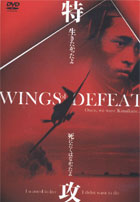
Wings of Defeat 2007
Distributed by New Day Films, 190 Route 17M, P.O. Box 1084, Harriman, NY 10926; 888-367-9154 or 845-774-7051
Produced by Risa Morimoto and Linda Hoaglund
Produced by Risa Morimoto and Linda Hoaglund
Directed by Risa Morimoto
DVD, color and b&w, 89 min.
Sr. High - Adult
Asian Studies, History, Military Studies, World War II
Date Entered: 04/08/2009
Reviewed by Jeremy Linden, Head of Archives and Special Collections, Daniel A. Reed Library, State University of New York College at Fredonia, Fredonia, NYMilitary history, particularly the history of World War II, occupies a certain pervasive significance in the American understanding of our past. Facets of the war, whether the Holocaust or Pearl Harbor, are taught to schoolchildren at a young age; the lessons and interpretations of those facets often stay with us for life. “Kamikaze”—the phenomenon of Japanese pilots who intentionally crashed their aircraft into American naval ships, killing themselves—is a universally recognized term in our society, bringing with it visions of ruthless, passionate men willing to sacrifice themselves for their nation, as well as a more recent vision of the men and attacks of September 11, 2001. Wings of Defeat is one woman’s exploration of the truth of that interpretation with surviving Kamikaze pilots themselves, and her sobering discovery of their fears, desires, and, unseen to Americans, humanity.
The documentary follows the film’s director, Risa Morimoto, as, inspired by her own uncle’s past, she traces the history of Kamikaze from the tactic’s first situational usage during MacArthur’s invasion of the Phillipines in October 1944, to its elevation as the central military strategy by the end of the war. One by one, misconceptions and stereotypes are cast aside by the words of the surviving pilots and modern historians. Rather than willing volunteers, they present the bitterness of Lieutenant Seki, the Japanese ace asked to sacrifice himself when no other officer would volunteer to lead the first unit. Rather than fanaticism, survivors speak of their smiles and salutes to fellow pilots, all while wondering, and dreading, when their own orders would come. The reality that only a small percentage of Kamikaze pilots ever made it to their targets is exemplified by the experiences of three of the survivors—one whose aircraft crashed into the ocean due to engine failure before he could ever engage the enemy, and two others whose aircraft, after the rest of their unit was shot down, was seemingly spared by American planes. Injured, and with a damaged plane, they lost their will to continue the mission and turned around. Nearly 3,000 of the pilots who died were “boy pilots” or “student soldiers,” often young men in their teens, recruited late in the war and brutally trained, the Kamikaze perhaps their first and only mission. Passion is discussed, displayed, but it is the passion of life, the passionate belief upon witnessing the devastation at Hiroshima and Nagasaki that war was not the answer, and the passionate disbelief that, once the war was over, their lives had been spared. The film is, in essence, the story of young men who are sentenced to death for their nation and their attempt to cope with and rationalize, both at the time and in retrospect, that sentence.
Wings of Defeat is highly recommended for its insightful look at the long-standing stereotype surrounding the Kamikaze of World War II. Modern interviews with surviving pilots are interspersed with the comments of historians, providing both personal reflection as well as historical perspective. Japanese archival footage, combined with American, is particularly poignant in telling the story; likewise, an illustrated sequence depicting an actual mission lends the film a unique aspect. A compassionate view toward men ordered into what was even then considered a horrific tactic; the mindset of the film is supported by interviews of American veterans who consider whether they would have used the same tactic if roles had been reversed. Wings of Defeat forces us to consider the human side of an enemy solidified by nearly 70 years of stereotypes; in the end we find that the Kamikaze were not all that different from our own fathers, uncles, and grandfathers—men who conquered their fears to carry out their orders.
The available teacher’s guide includes activities, exercises, and commentary from the director and historians, and also outlines the National History Standards for grades 5-12 that the film helps to address. Languages include English and Japanese with English subtitles. The DVD also includes an interview with Pulitzer Prize-winning historian John Dower. Please note that the archival footage does include some graphic content. Awards
- San Francisco International Asian American Film Festival, Winner, Special Jury Award, 2008
- International Documentary Film Festival Amsterdam, First Appearance Competition, 2007